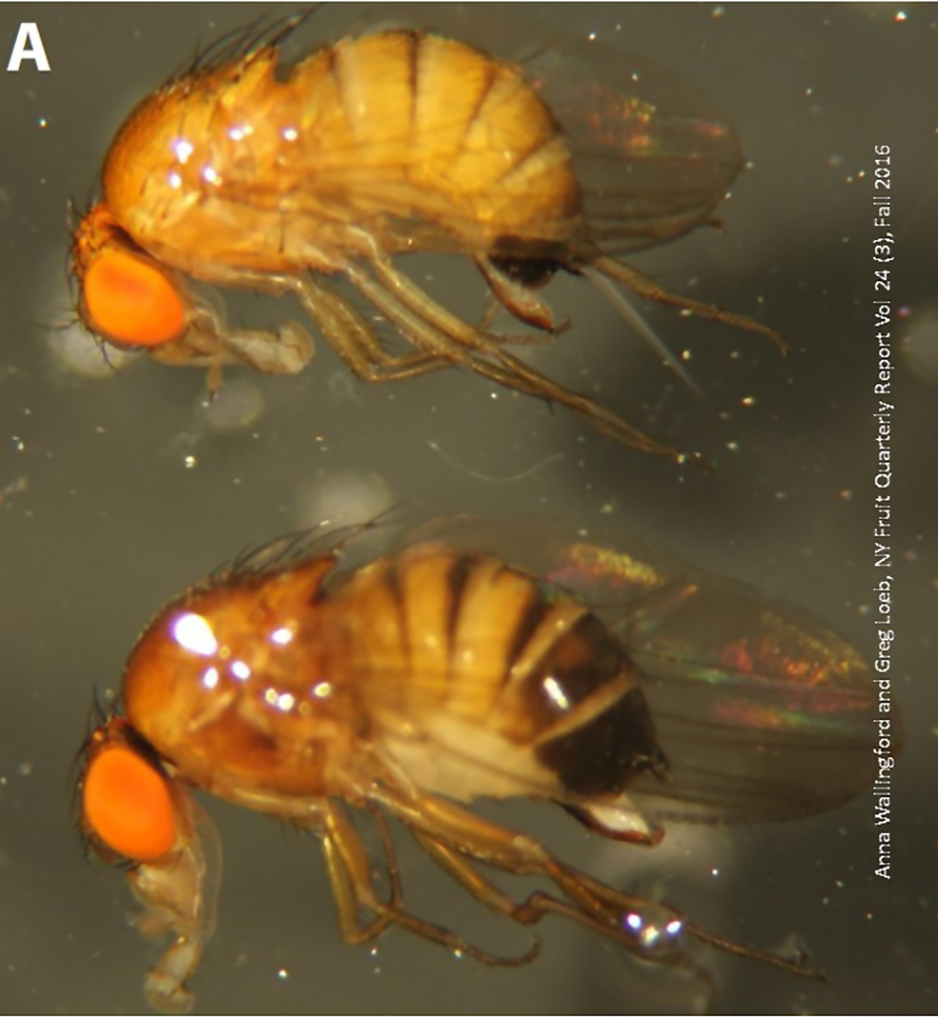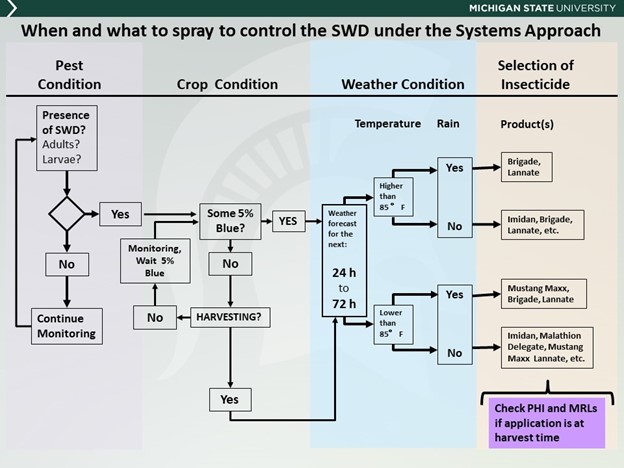West central Michigan small fruit update – July 12, 2023
Blueberry harvest is in progress. Blueberry maggot and spotted wing Drosophila are already active in fields.

West central Michigan remains under drought conditions, with daily minimum and maximum temperatures averaging 51 and 82 degrees Fahrenheit. For the past 15 days, no more than 0.52 inches of rain have accumulated in the area. This amount of rain does not supply blueberry fields with enough water to maintain a healthy crop. Although the spring-summer drought is not as severe as in 2022, its effects are more pronounced in fields with limited supplemental irrigation or fields where growers missed critical periods where irrigation could have made a difference.
Another factor is the variety. Fields with Bluecrop are showing more of the effect from high temperatures and drought conditions. Elliott and other late and mid-season varieties are doing fine with a nice crop and great fruit quality. Fields already in harvest are those planted with Bluetta, Brigitta and other early season varieties.
The harvest of Bluecrop started this week with fruit of excellent quality and flavor at fields where irrigation was applied in a timely manner. There are, however, fields where pollination was affected either by high temperatures or where flower thrips affected the pollination process. The harvest of those fields could be difficult because there are a few leading berries ready for harvest while the rest of the berries in the fruit cluster are still in early stages of development (Photo 1). If growers wait for the rest of the berries to turn blue, blueberries already ripe will lose firmness and quality, and they will become a breeding ground for spotted wing Drosophila (SWD) and blueberry maggot.
Regarding insect pest problems, blueberry maggot and SWD are already active in blueberry fields. Some localized rains occurring over the past days accelerated the emergence of blueberry maggot flies and they already have been trapped in yellow sticky traps at monitoring sites. On the other hand, SWD started arriving in Allegan and Van Buren County blueberry fields. However, SWD numbers are still small, and two-thirds of flies trapped at monitoring sites are overwintering females (smaller and darker than summer flies) with some flies already from the first summer generation (Photo 2).
.jpg)
Large numbers of wild blackberries and raspberries have been found with large numbers of SWD larvae at southwest Michigan blueberry fields. Therefore, growers need to be alert to the presence of SWD if they have fields ready for harvest or more than 5% of the fruit is already in the blue stage.

Table 1 presents some of the recommended insecticides to initiate SWD management. Photo 3 is a diagram showing when and what to spray under different weather conditions.
| Table 1. Key insecticides for spotted wing Drosophila control in blueberry and their response to environmental conditions during the application. | ||||||
| Insecticide | Class | Rainfastness | Heat affected | Penetration | Weather conditions | |
| Rainy, more than 0.5 inch | Hot, 90 degree or more | |||||
| Imidan | Organophosphate | Low | No | Limited | Reduced activity | Excellent |
| Malathion | Organophosphate | Low | Yes | No | Reduced activity | Reduced activity |
| Brigade | Pyrethroid | High | No | No | Excellent | Excellent |
| Mustang Maxx | Organophosphate | High | Yes | No | Excellent | Reduced activity |
| Lannate | Carbamate | Moderate | No | Yes | Excellent | Excellent |
| Assail | Neonicotinoid | Moderate | No | Yes | Excellent | Use it |
| Exirel, Verdepryn | Diamide | High | No | Yes | Excellent | Excellent |
| Delegate, Entrust WP, Entrust 2SC | Spinosyn | High | No | Yes | Excellent | Excellent |
| John Wise, Rufus Isaacs, Carlos Garcia-Salazar, Michigan State University Extension 2022. | ||||||



 Print
Print Email
Email
